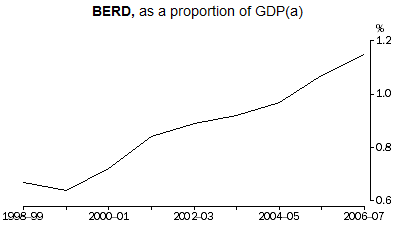|
|
|
|
|
|
|
News & Views item - October 2008 |
![]() Australian GERD as a Percent of GDP Rises Above 2% Solely on the Back of
Increased Private Sector Funding. (October 22, 2008)
Australian GERD as a Percent of GDP Rises Above 2% Solely on the Back of
Increased Private Sector Funding. (October 22, 2008)
Yesterday the Australian Bureau of Statistics made available its 2006-07 data on research and development expenditure in Australia.
The Executive director of the Federation of Australian Scientific and Technological Societies (FASTS), Bradley Smith has released the following assessment, saying that for the first time Australia has recorded a GERD figure higher than 2% which just edges Australia into the top ten of OECD nations.
[The data show] Australia’s gross expenditure on research and development (GERD) in 2006-07 was a record $21b, which represented 2.01% of GDP – the first time Australia has recorded a figure higher than 2%.
However, we cannot be complacent. Australian expenditure remains below the OECD
average of 2.26% in 2006-07 although the gap has closed considerably from
2002-03 when Australia invested 1.69% of GDP in R&D when the OECD average was
2.24%.
The increase of $5b (32%) between 2004-05 and 2006-07 was driven primarily by
business, which increased its expenditure by $3.4b and universities by $1.1b.
[Note: from 2005-06 to 2006-07 the majority came from the mining sector, manufacturing was essentially stagnant .]
 |
 |
Credit: ABS graphics
The time series data provided by the ABS highlights some significant structural
changes in R&D over the past 16 years, including;
Business share of total expenditure on R&D (BERD) has increased significantly from 44.1% in 1992 to 47.8% in 2000/1 to 57.3% in 2006/7.
In the same period, both Commonwealth and State/Territory Governments have halved their share of R&D with the Commonwealth falling from 17.8% in 1992/3 to 9.0% in 2006/7.
Universities’ share remains fairly constant at about 26% of gross expenditure).
Basic research as a proportion of national investment in R&D also declined from 12.1% in 1992 to 10.2% in 2000/1 to 8.4% in 2006/7.
The data also shows a significant and rapid
shift in socio-economic priorities with economic development dropping as a share
of Commonwealth and State Government research from around 60% to 44% between
2000/1 and 2006/7.
The re-orienting of research toward health and medical research in particular,
but also the environment and social development is perhaps a little surprising
given the commercialisation rhetoric of Backing Australia’s Ability.
With more than ⅔
of Government and higher education expenditure now in areas where Governments
have prime responsibility including health, environmental management and
defence, it raises important questions as to the capacity of Governments to be
wise and informed ‘research users’.
With research investment heading in the right direction, policy attention needs
to also focus on the real costs of research in universities and public sector
research agencies, and mechanisms to support greater mobility and knowledge
transfer between public and private sectors and internationally.